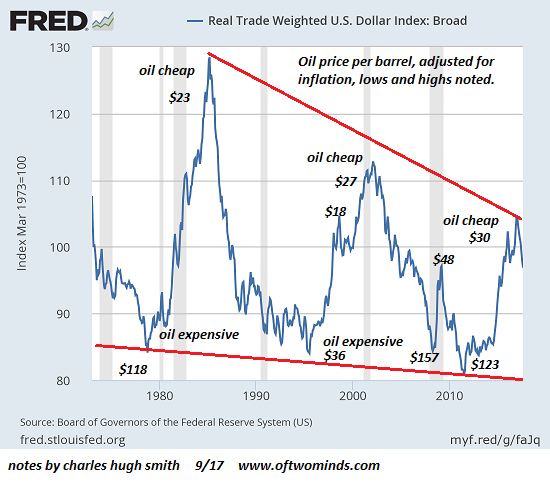You Can Only Choose One: Cheap Oil or a Weak Dollar
When the price of oil rises to the point of pain, just remember the handy-dandy discount mechanism: a much stronger US dollar.
Glance at this chart of the trade-weighted U.S. dollar, and note the swing highs and lows in the price of oil per barrel around each peak and trough. You can look up historical inflation-adjusted prices of oil in USD on this handy chart: Crude Oil Prices – 70 Year Historical Chart (macrotrends.net)

The correlation isn’t perfect, of course. Oil was relatively cheap between 1986 and 2003, due to a relative abundance of supply as Saudi Arabia and new fields ramped up production, with two periods of extreme price action: a brief spike higher in 1990 preceding the First Gulf War, and a collapse to $17 in the 1998 Asian Contagion financial crisis.
Geopolitical crises, wars and supply shocks will move oil prices regardless of the value of the USD. That said, it’s clear that absent such shocks, there is a strong correlation between a stronger USD and lower oil prices (in USD of course) and a weaker dollar and higher oil prices.
The reason why is straightforward: if the dollar gains purchasing power against other currencies, it buys more oil for each dollar.
Conversely, when the USD weakens, its purchasing power declines and it takes more USD to buy an imported barrel of oil.
(Note that the price of domestically produced oil is largely set on the global marketplace. West Texas crude oil may be a few dollars less per barrel than Brent crude oil, but if the global price skyrockets, so does the price of US-produced crude.)
Since oil and gas are the essential resources of the industrial economy, the price paid by consumers and commercial users matter.
…click on the above link to read the rest of the article…